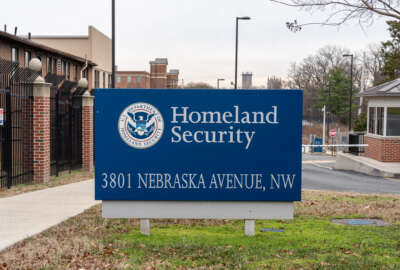NIST begins outreach for new public safety network
In a request for comments issued today, the agency wants industry to answer 10 questions across four broadly themed areas.
wfedstaff | June 4, 2015 10:59 am
By Jason Miller and Jared Serbu
Federal News Radio
The National Institute of Standards and Technology is seeking input on the research and development priorities for a nationwide broadband public safety network.
Through a notice and request for comments in today’s Federal Register, NIST is asking industry, academia, the public safety community and any other stakeholders to help meet three basic goals to create a new interoperable network. The results of this inquiry will help direct spending in the President’s Wireless Innovation (WIN) Fund, which the administration wants to create to help drive innovation of next-generation network technologies.
The goals of NIST’s request for information are to:
- Document public safety requirements and drive adoption of those requirements into standards;
- Develop the capability for communications between currently deployed public safety narrowband systems and the future nationwide broadband network;
- Establish a roadmap to capture and address public safety’s needs beyond what can be provided by the current generation of broadband technology and drive technological progress in that direction.
The NIST notice includes a list of more than a dozen features the agency envisions in a future public safety network, organized around four themes: resiliency, reliability, security and affordability.
“It’s a baseline, and it’s certainly not something we’re expecting to meet on day one,” said Dereck Orr, the program manager for NIST’s public safety communications research program in an interview with Federal News Radio. “And part of the effort is to ask people what’s missing. If there’s something that you believe is imperative that should be on here, we’d like to hear from you and get your thoughts on what is a critical element of a public safety network.”
Information is due back to NIST by Oct. 12.
Orr said early versions of the network are not expected to meet all of the needs of public safety agencies. For example, while the system is envisioned to eventually support interoperable voice communications, the first iterations of 4G public safety deployments will likely be for data only.
And large scale commercial implementations of 4G technology lack many of the attributes that are critical to public safety communications, Orr said, such as the ability to operate independently of fixed wireless infrastructure in situations where a cell tower is out of reach, damaged, or otherwise unavailable.
“Public safety wants to leverage the commercial 4G market, but there are major gaps for public safety,” he said. “For example, if I’m in a building and I can’t get a signal out, I can talk to the guy down the hallway from my handset to his handset without having to worry about going through a cell tower. That’s a core feature that public safety currently utilizes.”
NIST hopes to zero in on other such areas that are specific to public safety so it can spend its limited research dollars wisely, and avoid duplicating the work of private network operators.
“We really need to understand what’s being done in the commercial world, what is already met through commercial services or commercial off the shelf equipment, so we can really focus in on the key gaps where public safety needs an influx of research and development for things that are core issues for them but aren’t in the top priorities of the commercial networks.”
The network is envisioned to operate in a 10 megahertz-wide piece of spectrum in the 700 megahertz band that is already dedicated to public safety nationwide. It could also be combined with another adjacent piece of 10 megahertz real estate that has been the subject of a Congressional and regulatory stalemate for several years.
Competing proposals have involved directly granting the additional frequencies for public safety use; others contemplate auctioning it off to private network operators under the idea that they would build the physical infrastructure to operate the network and share it with public safety users, giving emergency responders first priority when the need arose. The Federal Communications Commission attempted such an auction in 2008, but no company met the FCC’s minimum bid.
President Barack Obama made WIN part of his Wireless Innovation and Infrastructure Initiative (W3I) and wants to reinvest $10.7 billion into the development and deployment of a public safety 4G wireless network.
The administration also wants a $3 billion WIN Fund to help drive innovation through research, experimentation, testbeds, and applied development. Of the $3 billion, $500 million will be devoted to research and development (R&D) for the new public safety broadband network.
The President detailed WIN and the WI3 initiative as part of his fiscal 2012 budget request sent to Congress in February.
The administration planned to submit a legislative proposal to Congress to auction spectrum licenses and raise an estimated $27 billion, of which $500 million would go to NIST to oversee the Public Safety Innovation Fund.
The Justice Department in August 2010 held a forum on public safety broadband needs with more than 20 public safety experts. They identified 15 operational requirements across four overarching themes: resiliency; availability and reliability; security and affordability and commercial alignment.
NIST wants input on 10 questions about these four areas and 15 elements, including current gaps, possible R&D and short-term and long-term affordability concerns.
This isn’t the first time the government has (http://www.federalnewsradio.com/?nid=33&sid=2523866) considered building a public safety wireless network. DoJ tried to create a $3 billion nationwide law enforcement network, called Integrated Wireless Network (IWN) in 2006. IWN’s goal is to consolidate and share existing government infrastructure wherever possible and modernize the disconnected land mobile radio networks across Justice bureaus, including the FBI, Drug Enforcement Agency and the Bureau of Alcohol, Tobacco, Firearms and Explosives.
While Justice is making progress, creating such a nationwide network was more difficult than first imagined.
The Bush administration also created the Safecom program in 2002 to help promote an interoperable public safety network. The initiative focused on standard setting across the community, but didn’t try to develop an actual network.
RELATED STORIES:
Post-9/11, emergency radios still not connected
DHS: Smartphones ‘next stage’ of emergency communications
Copyright © 2025 Federal News Network. All rights reserved. This website is not intended for users located within the European Economic Area.





